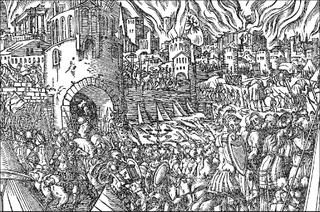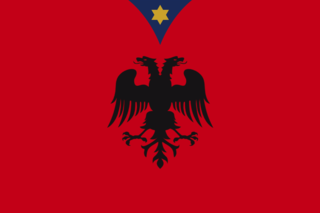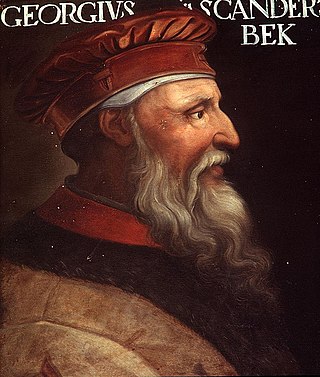
The League of Lezhë, also commonly referred to as the Albanian League, was a military and diplomatic alliance of the Albanian aristocracy, created in the city of Lezhë on 2 March 1444. The League of Lezhë is considered the first unified independent Albanian country in the Medieval age, with Skanderbeg as leader of the regional Albanian chieftains and nobles united against the Ottoman Empire. Skanderbeg was proclaimed "Chief of the League of the Albanian People," while Skanderbeg always signed himself as "DominusAlbaniae".

The Battle of Albulena, also known as the Battle of Ujëbardha, was fought on 2 September 1457 between Albanian forces led by Skanderbeg and an Ottoman army under Isak bey Evrenoz and Skanderbeg's nephew, Hamza Kastrioti.

The first siege of Krujë occurred in 1450 when an Ottoman army led by Sultan Murad II and his crown prince Mehmed II tried to besiege the Albanian town of Krujë. The League of Lezhë, led by Skanderbeg, experienced low morale after losing Svetigrad and Berat between 1448 and 1450. Nevertheless, Skanderbeg's exhortations and the support of the clergy, who claimed to have had visions of angels and victory, motivated the Albanians to defend the capital of the League, Krujë, at all costs. After leaving a protective garrison of 4,000 men under his trusted lieutenant Vrana Konti, Skanderbeg harassed the Ottoman camps around Krujë and attacked the supply caravans of Sultan Murad II's army. By September, the Ottoman camp was in disarray as morale sank and disease ran rampant. The Ottoman army acknowledged that the castle of Krujë would not fall by strength of arms, lifted the siege, and made its way to Edirne. Soon thereafter, in the winter of 1450–51, Murad died in Edirne and was succeeded by his son, Mehmed II.

The second siege of Krujë took place from 1466 to 1467. Sultan Mehmed II of the Ottoman Empire led an army into Albania to defeat Skanderbeg, the leader of the League of Lezhë, which was created in 1444 after he began his war against the Ottomans. During the almost year-long siege, Skanderbeg's main fortress, Krujë, withstood the siege while Skanderbeg roamed Albania to gather forces and facilitate the flight of refugees from the civilian areas that were attacked by the Ottomans. Krujë managed to withstand the siege put on it by Ballaban Badera, sanjakbey of the Sanjak of Ohrid, an Albanian brought up in the Ottoman army through the devşirme. By 23 April 1467, the Ottoman army had been defeated and Skanderbeg entered Krujë.
The third siege of Krujë by the Ottoman Empire took place in the summer of 1467 in Krujë in Albania.

Gjergj Kastrioti, commonly known as Skanderbeg, was an Albanian feudal lord and military commander who led a rebellion against the Ottoman Empire in what is today Albania, North Macedonia, Greece, Kosovo, Montenegro, and Serbia.
The Battle of Torvioll, also known as the Battle of Lower Dibra, was fought on 29 June 1444 on the Plain of Torvioll, in what is modern-day Albania. Gjergj Kastrioti Skanderbeg was an Ottoman Albanian general who decided to go back to his native land and take the reins of a new Albanian League against the Ottoman Empire. He, along with 300 other Albanians fighting at the Battle of Niš, deserted the Ottoman army to head towards Krujë, which fell quickly through a subversion. He then formed the League of Lezhë, a confederation of Albanian princes united in war against the Ottoman Empire. Murad II, realizing the threat, sent one of his most experienced captains, Ali Pasha, to crush the new state with a force of 25,000-40,000 men.

The Principality of Kastrioti was one of the Albanian principalities during the Late Middle Ages. It was formed by Pal Kastrioti who ruled it until 1407, after which his son, Gjon Kastrioti ruled until his death in 1437 and then ruled by the national hero of Albania, Skanderbeg.
The Battle of Otonetë occurred on September 27, 1446, in upper Dibra in Albania. The Ottoman commander, Mustafa Pasha, was sent into Albania, but was soon intercepted and defeated by Skanderbeg. It was one of the many victories won by Skanderbeg.
The First Battle of Oranik took place during the Albanian-Venetian War of 1447-1448, when the Republic of Venice allied with the Ottoman Empire against the League of Lezhë. The Albanian forces under Skanderbeg defeated the Ottoman army led by Mustafa Pasha during a battle that took place near Oranik of Upper Dibra, and two months later, peace was established between Albania and Venice.

The siege of Svetigrad or Sfetigrad began on 14 May 1448 when an Ottoman army, led by Sultan Murad II, besieged the fortress of Svetigrad. After the many failed Ottoman expeditions into Albania against the League of Lezhë, a confederation of Albanian Principalities created in 1444 and headed by Skanderbeg, Murad II decided to march an army into Skanderbeg's dominions in order to capture the key Albanian fortress of Svetigrad. The fortress lay on an important route between present-day North Macedonia and Albania, and thus its occupation would give the Ottomans easy access into Albania.

The Battle of Polog was the result of an Albanian incursion into Ottoman territory. Aided by Alfonso the Magnanimous, the Albanian leader Skanderbeg made plans to recapture Svetigrad, which had been lost in 1448. His strategy involved launching an invasion of Macedonia to devastate the country surrounding Svetigrad and to lure the garrison into a trap. While implementing this, he was stopped in the fields of Polog near Tetovo by a force which was planning to invade Albania led by his old friend Ibrahim Pasha. The force was quickly destroyed and Skanderbeg's army proceeded its looting before returning to Debar.

Vrana, historically known as Vrana Konti was an Albanian military leader who was distinguished in the Albanian-Turkish Wars as one of the commanders of Gjergj Kastrioti Skanderbeg, of whom he was one of the closest councillors. He probably belonged to the class of small lords who were tied to the Kastrioti family and possibly belonged to a common lineage (fis) with them. In his youth, he fought as a mercenary in the armies of Alfonso the Magnanimous. The term conte ("count") with which he became known in historical accounts didn't refer to an actual title he held, but to his status as a figure of importance.
Skanderbeg's Macedonian campaign was a preemptive campaign into the Ottoman Empire in Macedonia by Skanderbeg to defeat three Ottoman armies which had been prepared for the joint-invasion of Albania. From 1461 to 1462, Skanderbeg campaigned in Italy to protect his ally, Ferdinand I, from being overrun by the Angevin dynasty which claimed the Kingdom of Naples. Before setting out for Italy, Skanderbeg forged a truce with Sultan Mehmed II. Upon returning to Albania after securing Ferdinand, the Venetians became hostile to Skanderbeg and a sort of undeclared war took place. Mehmed saw an opportunity to attack Skanderbeg and sent three armies in one year. All three were defeated by Skanderbeg, however, in August 1462.
On August 1465, Ballaban Badera, a sanjakbey of the Sanjak of Ohrid who was an Albanian-born janissary launched his fourth but largest campaign against Skanderbeg. He was defeated in both battles of Ohrid and Vajkal the year before. Ballaban had previously inflicted severe casualties on Skanderbeg's forces and soon received high favor from Mehmet II. He soon appointed Ballaban and Jakup Arnauti—both Albanian peasants by birth—to lead a joint-campaign against Skanderbeg's forces. According to some scholars, this act of inclusion by the Sultan was a promotion of a social revolution within Albania to wean forces away from Skanderbeg.
The Ottoman invasion of Albania in 1452 was a campaign by the newly acceded Ottoman sultan Mehmed II against Skanderbeg, the chief of the League of Lezhë. Shortly after the first siege of Krujë, Murad II died in Edirne, and was succeeded by his son Mehmed II. Mehmed ordered nearly annual invasions of Albania which often resulted in multiple battles in one year. The first of these expeditions was sent in 1452 under the dual command of Hamza Pasha and Tahip Pasha, with an army of approximately 25,000 men.
The Second Battle of Mokra occurred on July 7, 1462, right before Skanderbeg's Macedonian campaign. Sultan Mehmed II had come out of his recent campaigns victorious, adding large swaths of lands to his domains. He was confident enough to send a new force into Albania to weaken the Albanian forces. He thus sent an army under Sinan bey to complete the job. Skanderbeg had been prepared and moved towards the Albanian frontier. The armies came near Mokra where Skanderbeg had positioned his forces on a mountain dominating the landscape. When the Turkish force got near enough, the Albanians ambushed and the Turks routed. Skanderbeg then raided Macedonia and shared the loot with his men.
This timeline lists important events relevant to the life of the Albanian feudal lord and military commander Gjergj Kastrioti Skanderbeg, widely known as Skanderbeg.

Skanderbeg's rebellion was an almost 25-year long anti-Ottoman rebellion led by the Albanian military commander Skanderbeg in what is today Albania and its neighboring countries. It was a rare successful instance of resistance by Christians during the 15th century and through his leadership led Albanians in guerrilla warfare against the Ottomans.

The Albanian-Ottoman Wars (1432–1479) were a series of wars and revolts against the rising Ottoman Empire by Albanian feudal lords. The wars and revolts took place in present-day Albania, Montenegro, Kosovo, North Macedonia and South Serbia. In this period, Albanians under the leadership of Gjergj Arianiti and especially later under Skanderbeg resisted the Ottomans under two Sultans in over 30 battles. Skanderbeg continued this resistance until his death in 1468, and the Albanians persevered for another 11 years before being defeated.










